As torrential rains battered the Basque Country, Deportivo Alavés and Real Madrid engaged in a slugfest at the Mendizorrotza Stadium. Between the field and weather conditions, as well as some chippy play from the two sides, Wyscout recorded 51 minutes and 30 seconds of dead ball time.
While that doesn’t include the ten minutes of stoppage time, it does give an idea of VAR usage, foul protests and the impact of the weather on the way the game was played. In the end, Zinedine Zidane’s saw his men grind out a 2-1 La Liga win to momentarily go top of the table.
In this tactical analysis, we will address the tactics employed by Real Madrid and Alavés, providing an analysis of the way the game played out.
Lineup
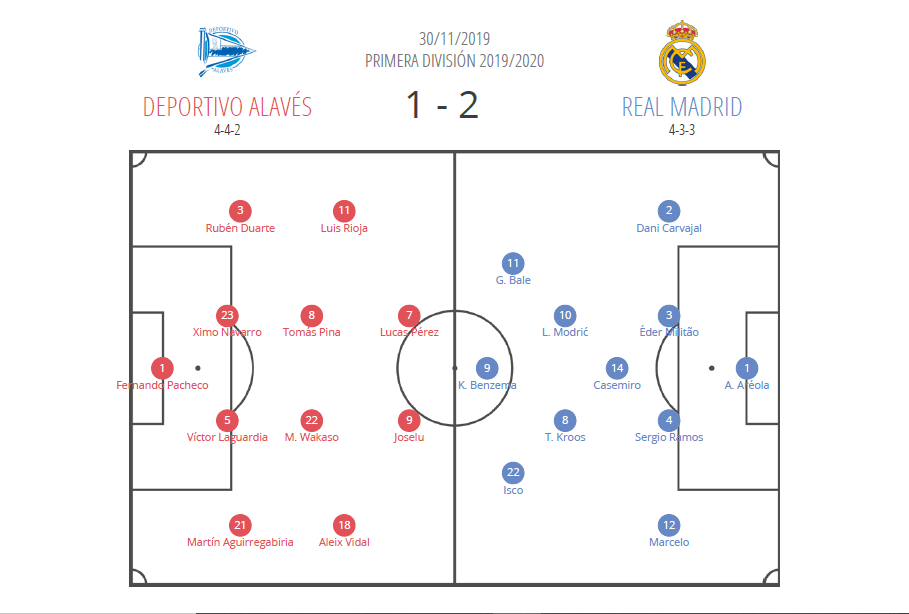
Starting with the home side, Asier Garitano set out his side in a 1-4-4-2. Fernando Pacheco manned the net while Víctor Laguardia and Ximo Navarro played in front of him with Rubén Duarte and Martín Aguirregabiria to their left and right respectively. In the midfield, Luis Rioja and Barcelona castaway Aleix Vidal operated on the wings with Tomás Pina and Mubarak Wakaso holding down the middle. Lucas Pérez teamed up with Joselu, the former Real Madrid man, up top to round out the formation.
As for Zidane, he rolled out his standard 1-4-3-3. Alphonse Areola started in goal with Eder Militão and Sergio Ramos as his centre-backs and the wing combination of Dani Carvajal and Marcelo. Casemiro played the pivot with Luka Modric and Toni Kroos joining him in midfield. Gareth Bale made his first start since his return from a controversial international break. Karim Benzema played up top while Isco alternated between a free role and the left-wing.
Alavés starts slow
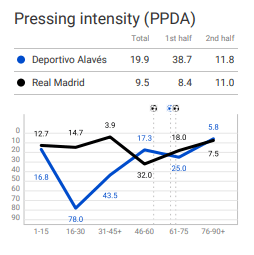
In the first half, Alavés took a more cautious approach, sitting much further back and absorbing pressure. With the field and weather conditions limiting the pace of the game, Alavés was happy to use the weather in their favour. Looking at the pressing intensity graphic above, the stats show Alavés was prepared to deny space while limiting the activity of Real Madrid’s attackers. Pressing intensity offers a statistical measure of passes per defensive action in a team’s defensive half.
As the first half played out, you could see they wanted to not only limit space behind the backline but also force Ramos to take on the playmaking role. Each time Kroos, Modric, or Isco dropped deep to receive, they were immediately pressed. Ramos was typically their only passing option.
In transitional moments after attacking high up the pitch, Alavés was very aggressive pressing while the team got its shape. Most of that can in the second half. During the first half, Alavés owned a paltry 32% possession and averaged 0.19 attacks per minute (as opposed to 0.45 in the second).
The difference in tempo from the first to the second half was staggering. Ramos’ goal forced Alavés out of their shell, but so did his ability to find teammates high up the pitch. A little later in this analysis, we’ll highlight a case in which Ramos did just that.
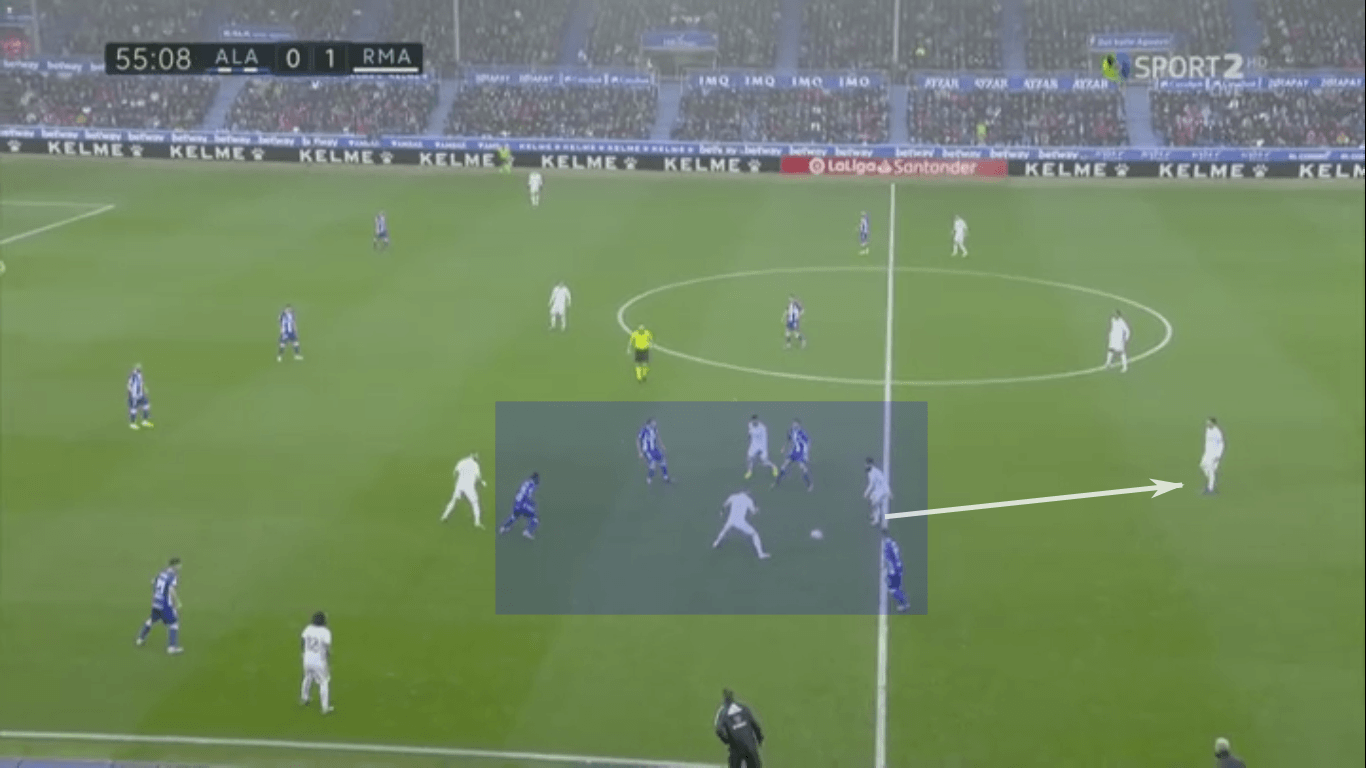
After Real Madrid recovers the ball near midfield, Alavés closes space quickly, forcing Real Madrid backward. With the ball at Ramos’ feet, he exchanges a couple of passes with his teammates before the ball returns to his feet.
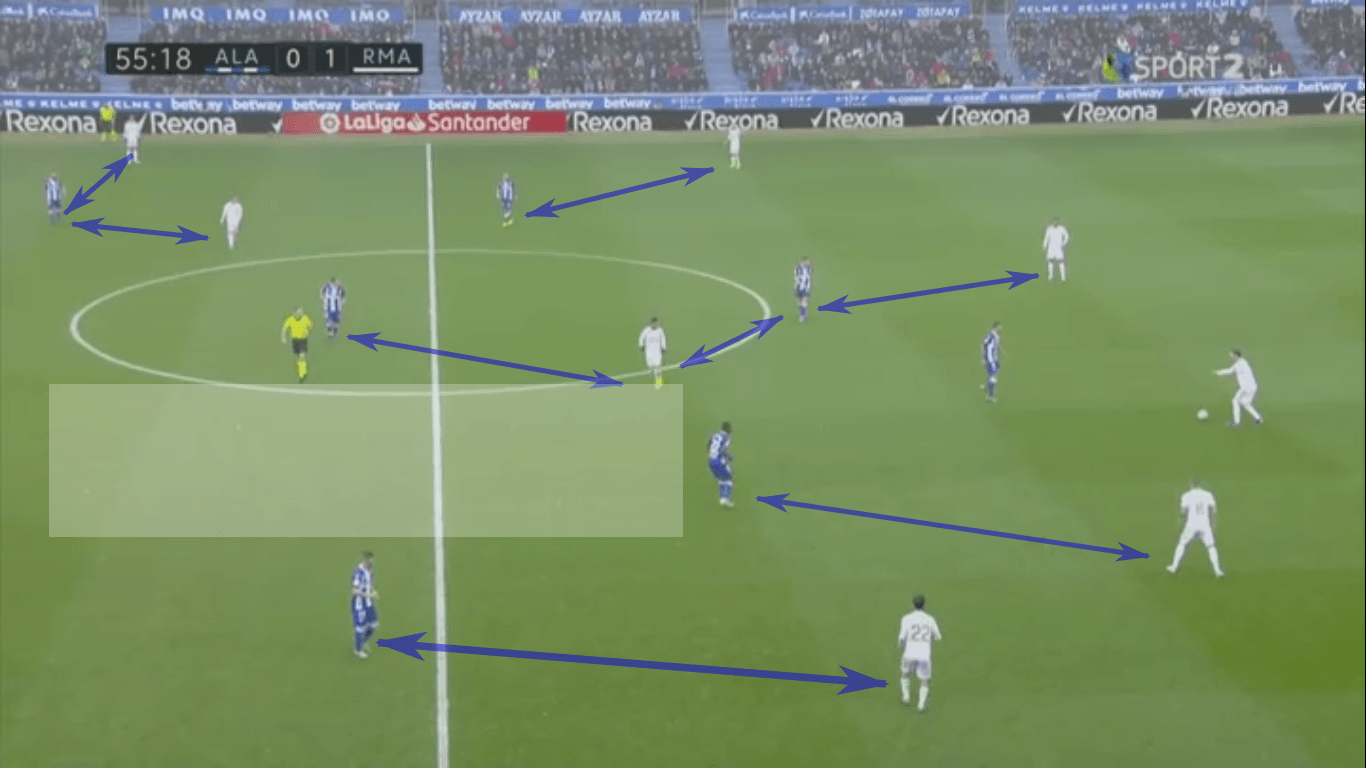
With some time on the ball, Ramos scoped his intermediate and long options, Alavés effectively closed all options for passes on the ground. You could argue that Casemiro was an option, but it was certainly not a clear-cut lane.
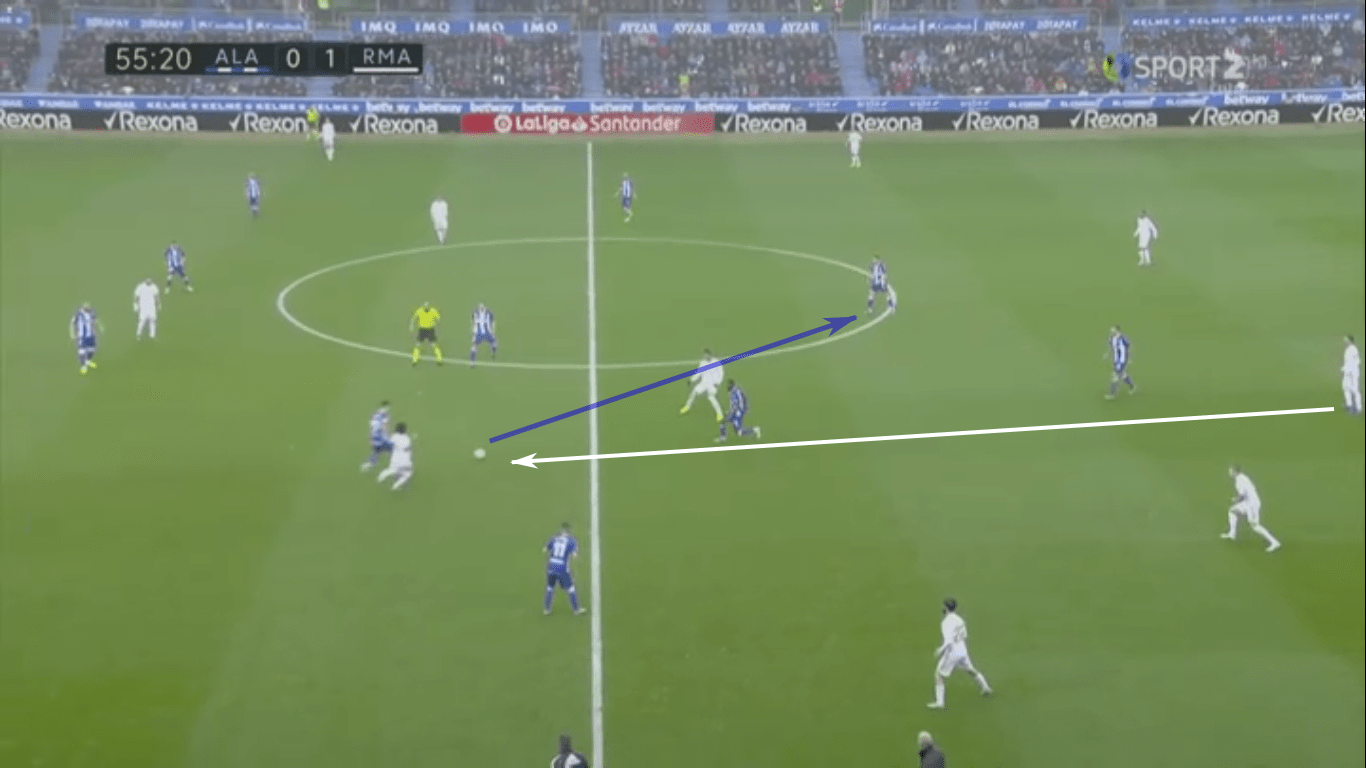
Ramos opted to play long on the ground to Marcelo. The window was tight and Marcelo was coming back from a high and wide position. Aguirregabiria won the footrace and play Pérez with his first touch. The counterattack allowed Alavés to reach the Madrid box, but Modric’s interception, which was met with hand-ball claims, ended the attack.
Utilizing the Long Ball
As commonly seen in the style of play of the underdogs, Alavés tended to be more direct, targeting their two forwards. Pérez and Joselu stayed near each other, the one to contest the header and the other to look for the second ball. With the midfield holding a narrow line, one of them was generally able to push forward in support of the forwards. Alavés had a tough time getting forward, failing to create a single shot from 18 from positional attacks.
With the torrential rains impacting the pitch, Real Madrid tended to progress down the wings and half-spaces with short and intermediate passes, incorporating switches of play if necessary. However, as Real Madrid were building up and connecting their lines against a compact Alavés defence, the deep sitting players were always looking for the more direct route to goal. As Real Madrid possessed in the middle third, the forward and outside-backs looked to create gaps and test the defence with runs in behind.
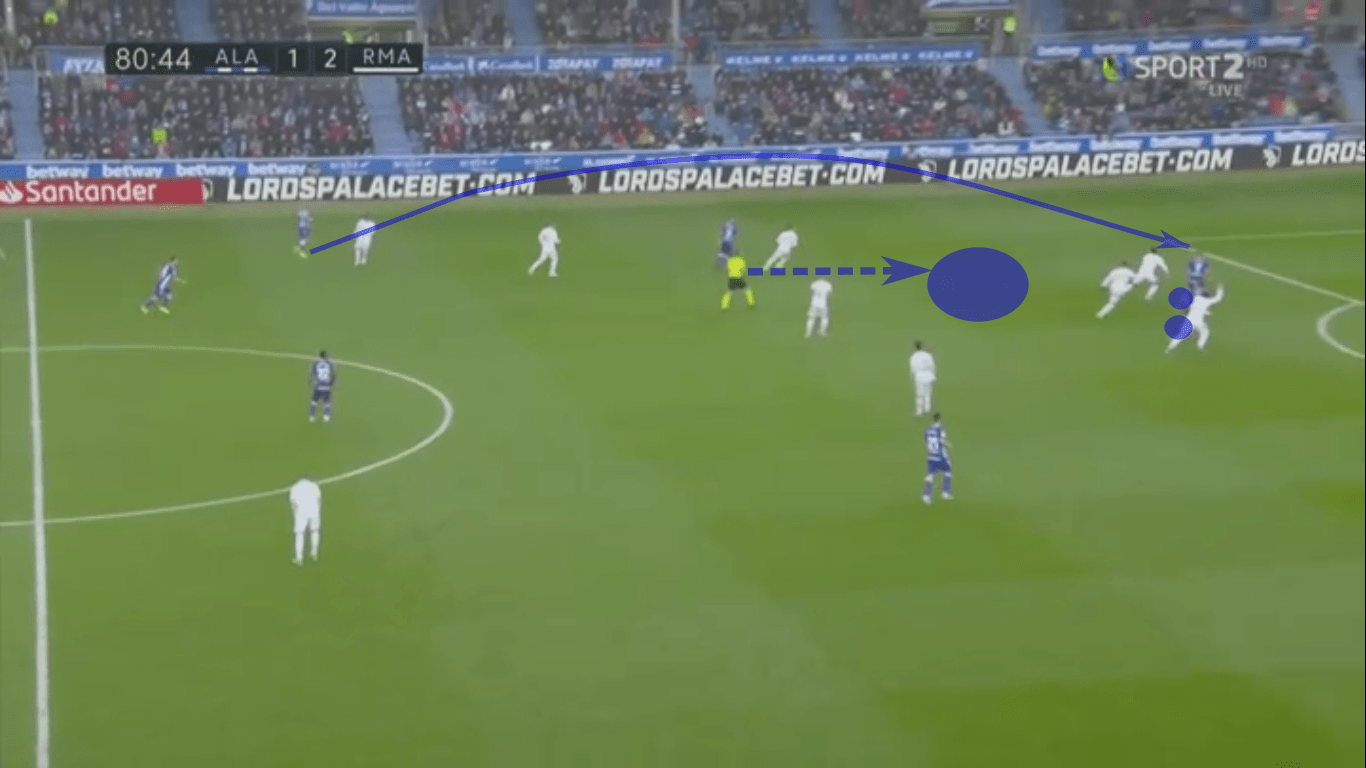
Vidal found a pocket of space on the left-wing. He held the ball for a moment, allowing his two forwards to give an indication where they wanted the ball. With their runs picked out, Vidal played forward.
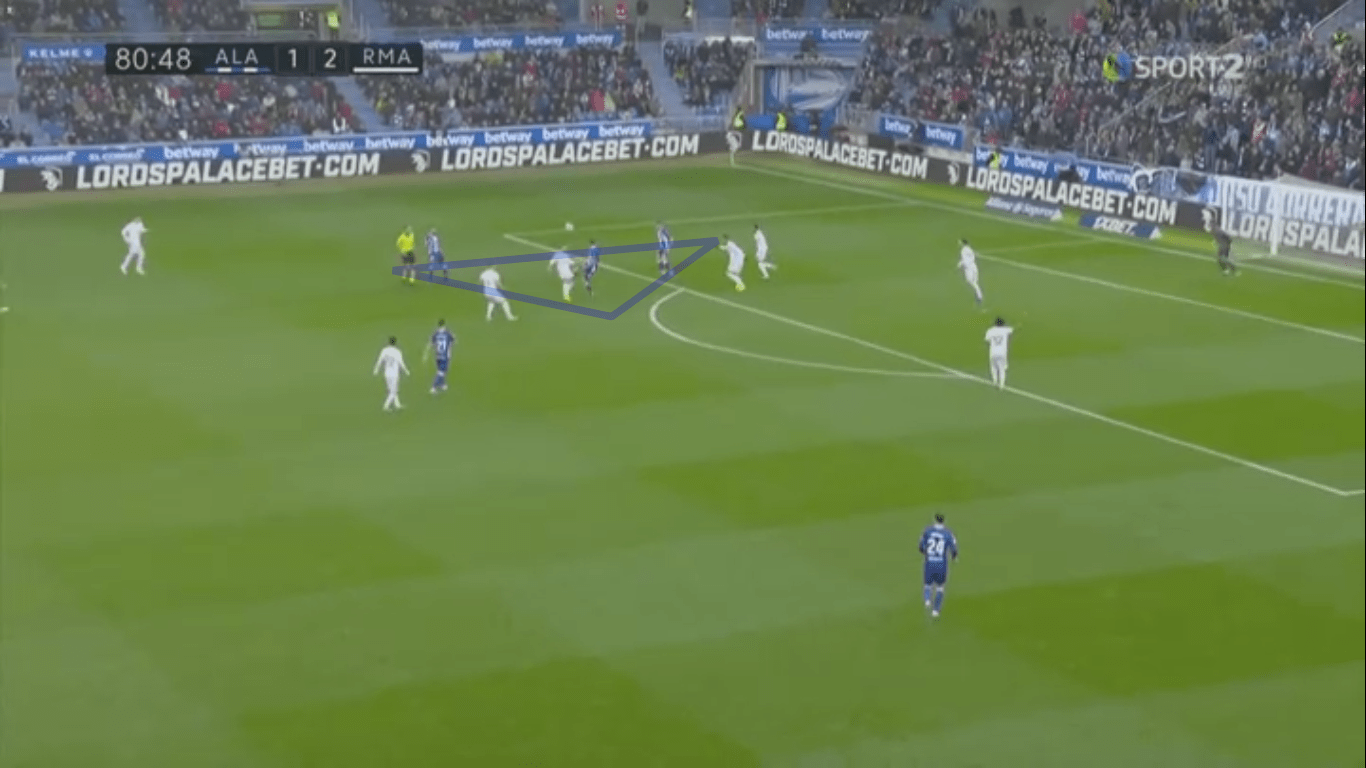
Militao won the header, but Joselu claimed the second ball. As the ball was in flight, Duarte made his run from the midfield. Joselu identified his teammate’s run and set the ball for Duarte’s volley. It’s poorly hit, but, in a game that didn’t see Alavés generating threatening opportunities in open play, this was the modus operandi in the Alavés attack.
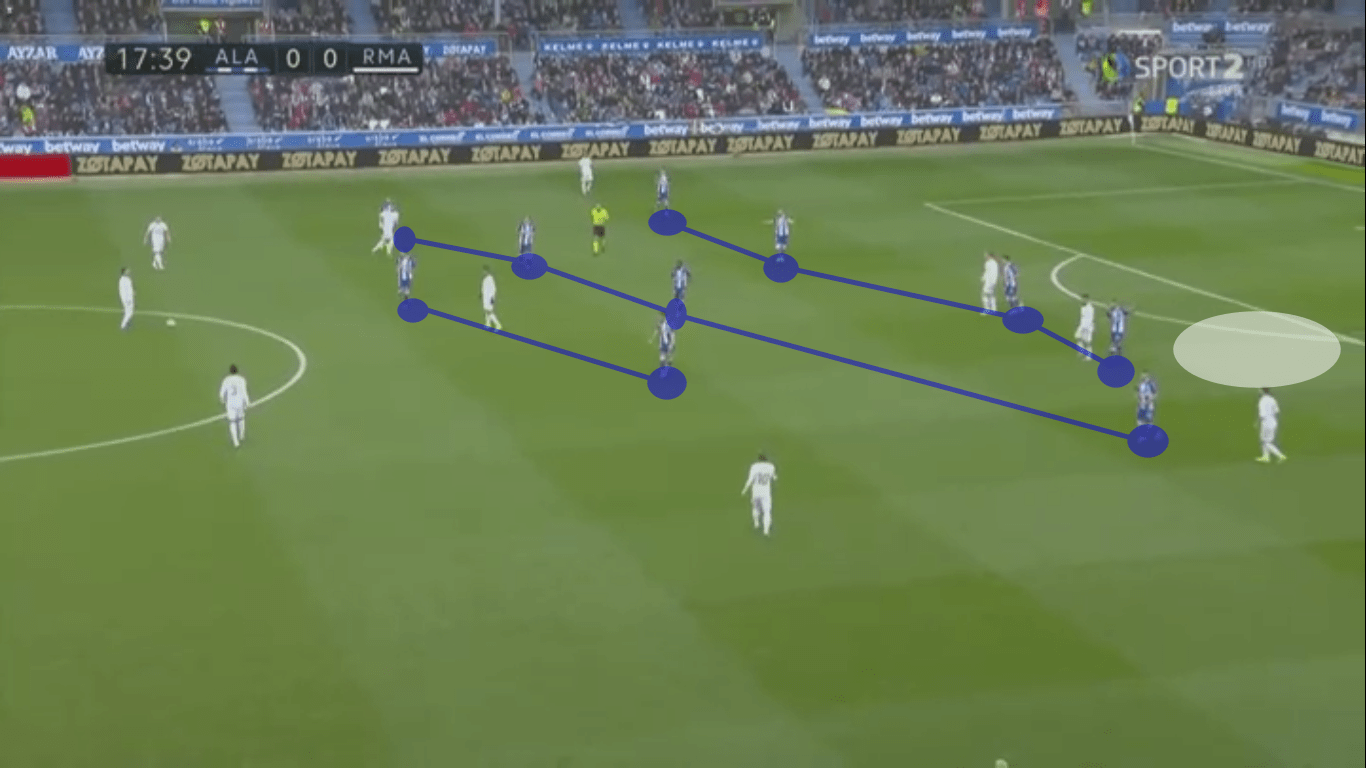
Turning to Real Madrid, we find them switching the play moving from left the right. The ball was played back to Ramos. With Alavés daring Ramos to take on the playmaker role, he had plenty of time to pick up his head and identify runs in behind the Alavés backline. Here we see a 3v3 on the right. Carvajal is behind Rioja, who has totally lost sight of the outside-back.
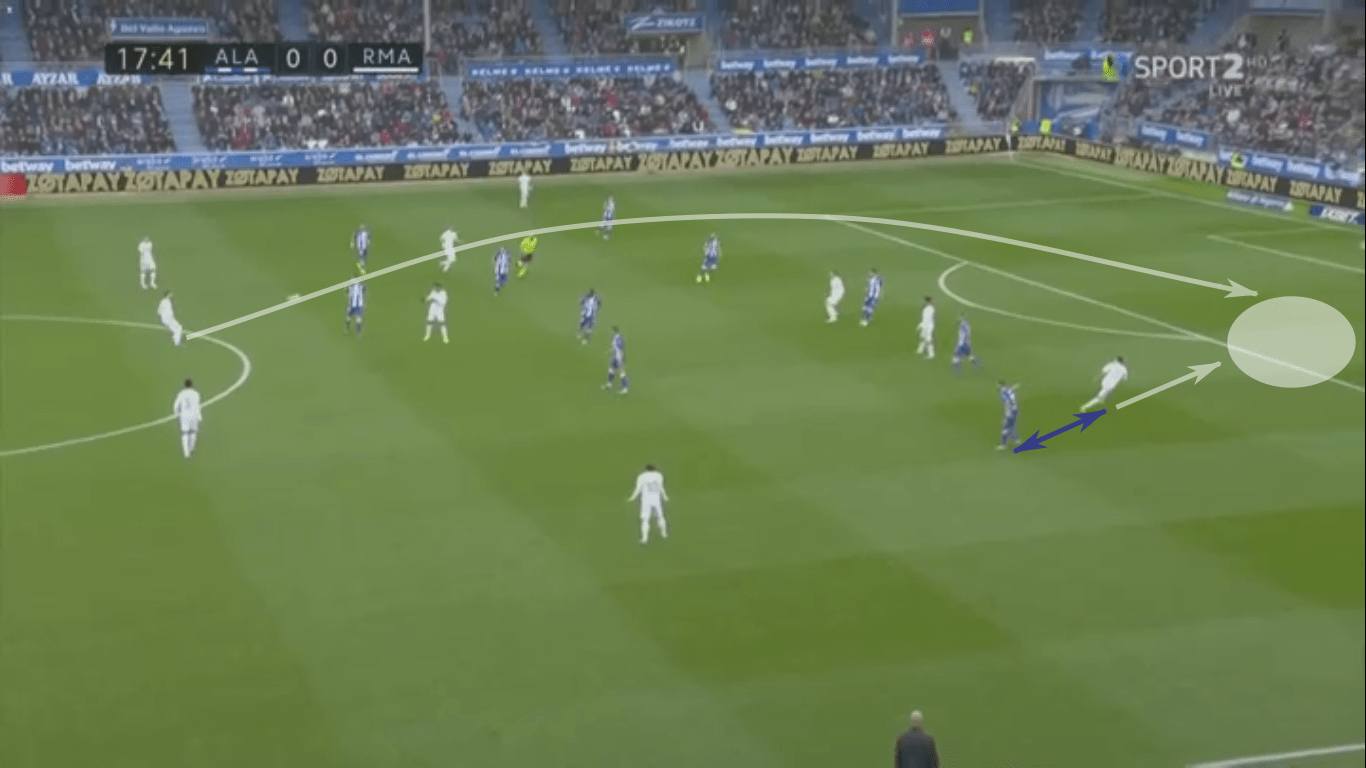
Carvajal made his move and timed his run perfectly. Ramos picked out his runner and delivered a beautiful ball over the top.
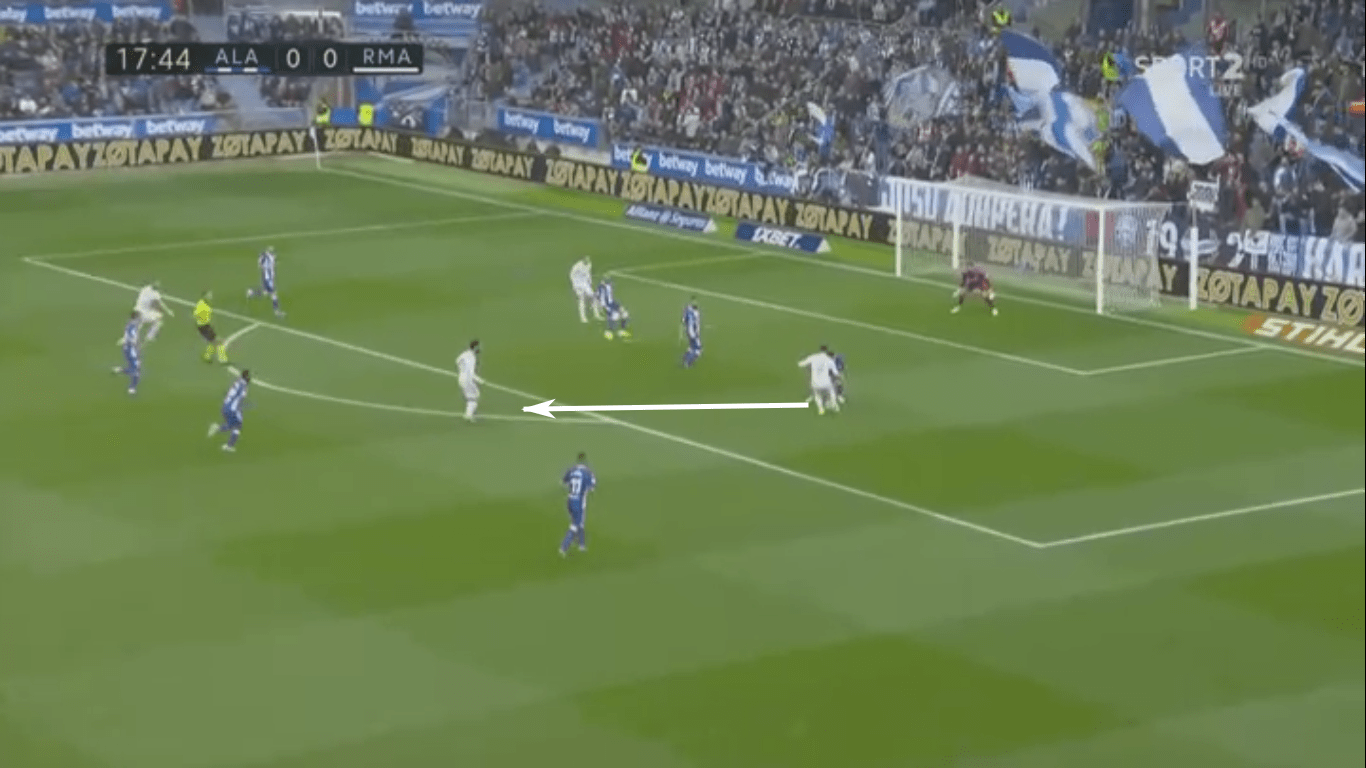
Carvajal’s first touch slowed him down enough to allow the defence to recover their ground, but the midfield wasn’t close enough behind them, which allowed Isco to receive a pass from Carvajal and direct a shot towards goal.
Real Madrid’s Triangulation
Throughout the game, players kept popping up in areas of the field that were far from their standard tactical role. There are too many rotations to speak of, so we’ll address the principle behind the movements.
At all times, Real Madrid looked to overload in groups of three attackers, preferably against three defenders. The highest of those three players was generally tasked with dragging his defender away from the backline. If successful, that movement would create a gap for the deepest or middle positioned attacker to exploit.
In the sequence I’ve selected to demonstrate this point, you will see the highest positioned player dictating which run builds off of his. Of Madrid’s 76 passes into final third, 59 were accurate, good for a 78% clip. Toni Kroos and Sergio Ramos were spectacular in this regard with the German completing 20 of 21 (95%) passes into the final third and the Captain completed 10 of 12 (83%).
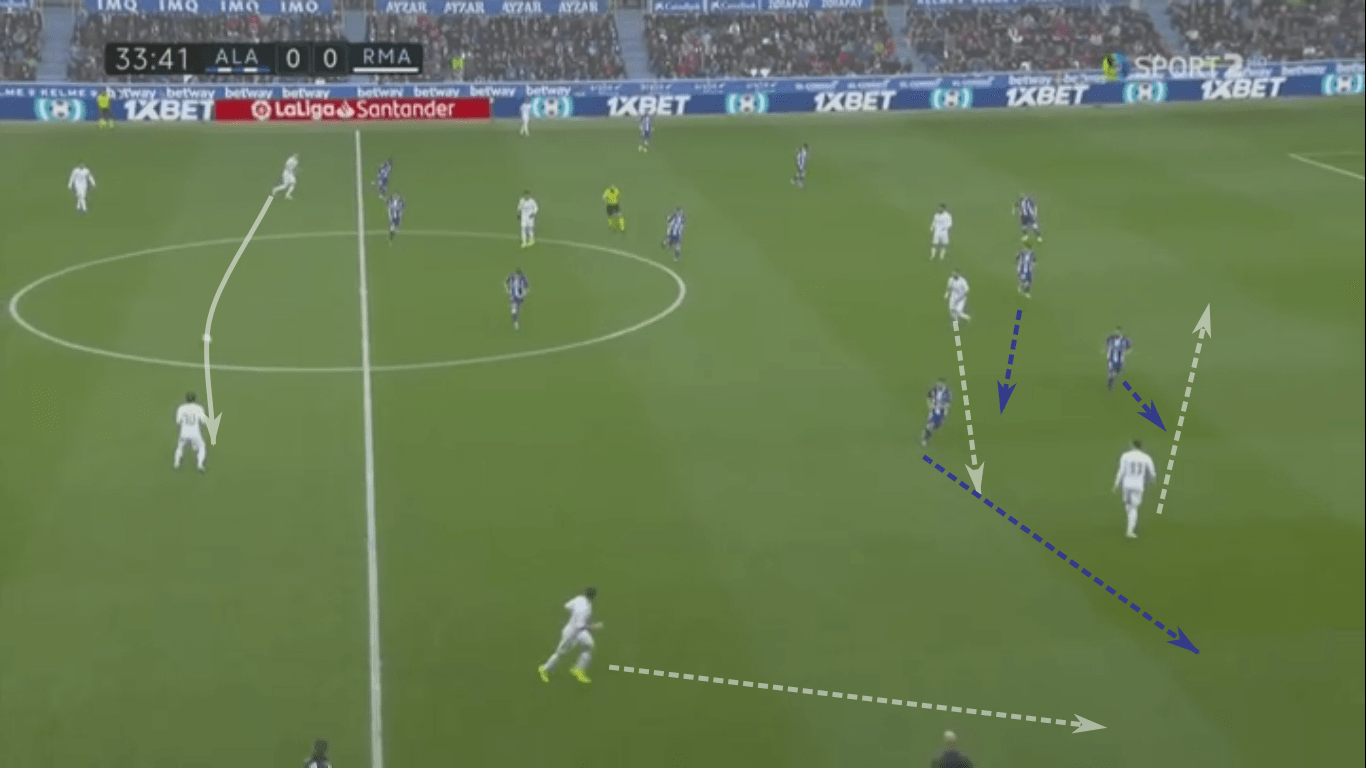
The sequence starts with a switch of play from Kroos to Modric. As the pass is en route to the Croatian maestro, the movement up top begins. Carvajal moves higher and wider, offering width and pulling Rioja away from the middle. You can see Benzema checking towards the ball, which provides a short option, but, more importantly, pulls Navarro away from the middle as the centre-back tracks Benzema’s run. Duarte is moving from his central position to the right, presumably to close the gap between himself and Bale.
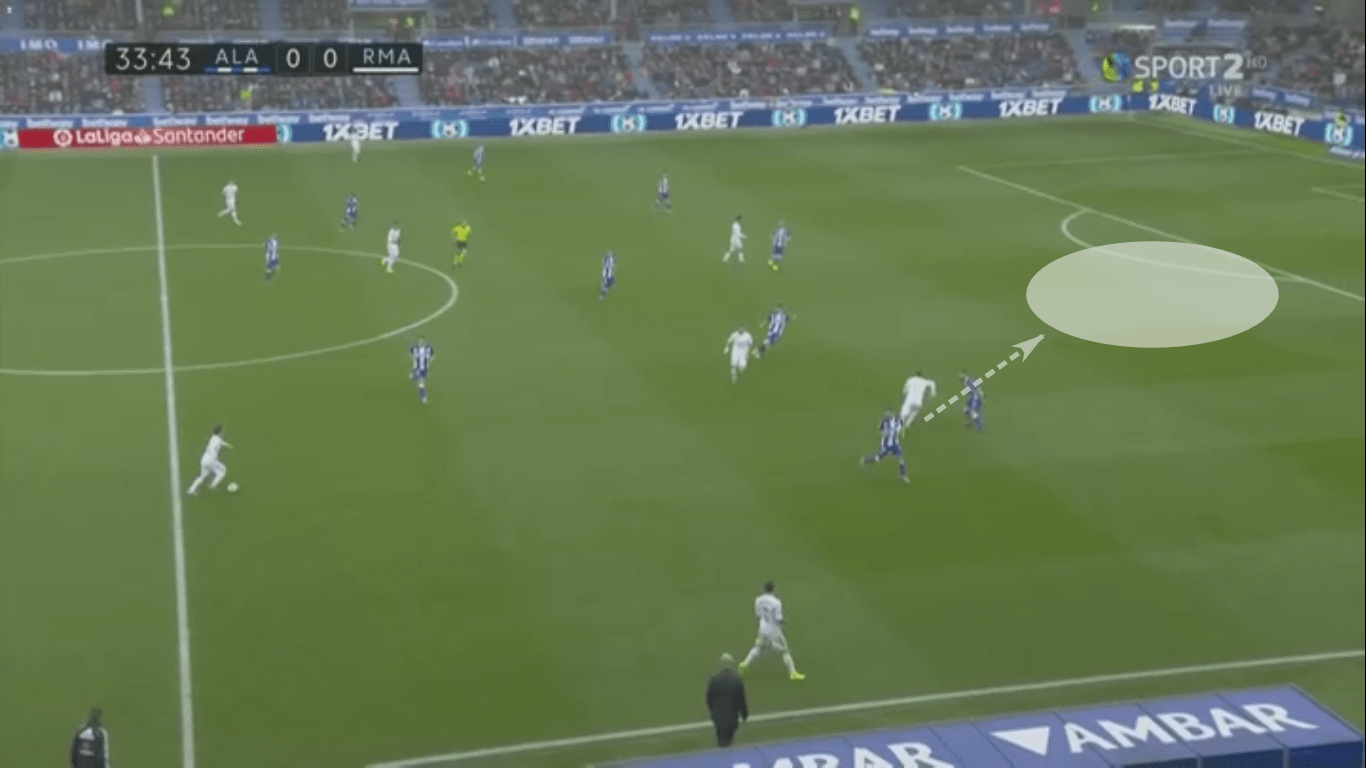
The movement works perfectly and Bale’s run to the inside is untracked by the defence. Unfortunately for Real Madrid, Modric doesn’t see the run in time to play his streaking forward and decides to play back to the left.
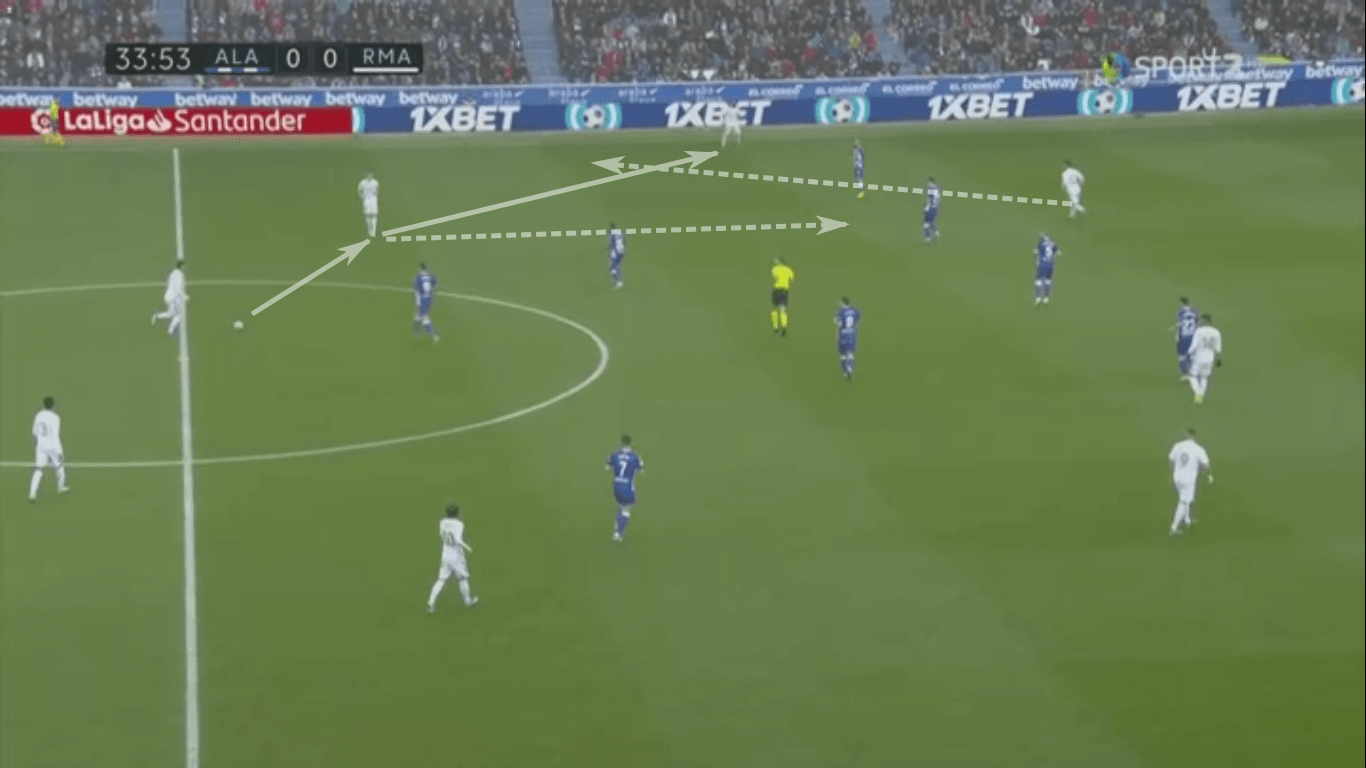
From Ramos to Kroos, play switched from right back to left. As Kroos received, he played Marcelo out wide and Isco finished his run behind Marcelo.
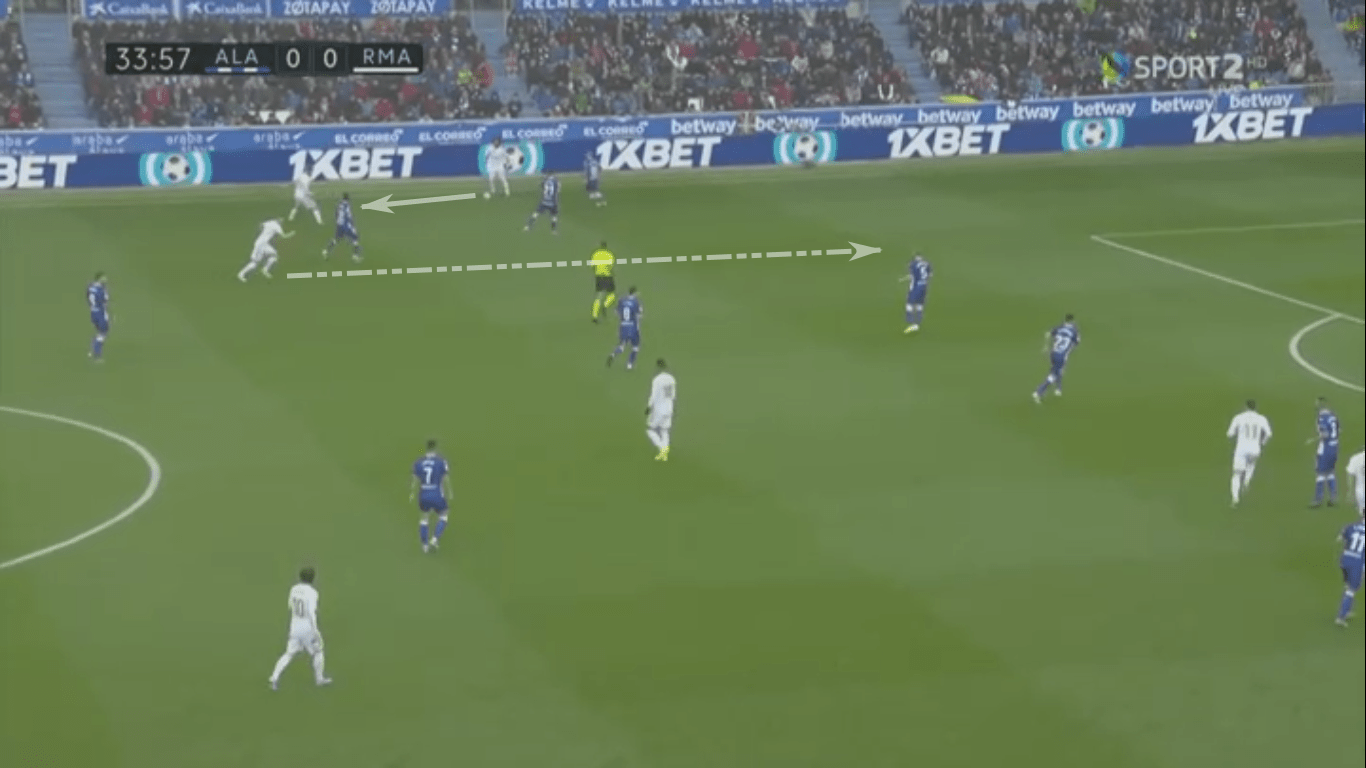
Just as the sequence on the right, the decision of the high player to track back opened up a large gap in the middle. Kroos was a little late to make the run forward. He seemed reluctant to make his run up the field, preferring to receive a return pass and play back to the right. You can see Bale is ready to make another run. This is speculation, but I think Kroos saw the run and preferred to play their instead.
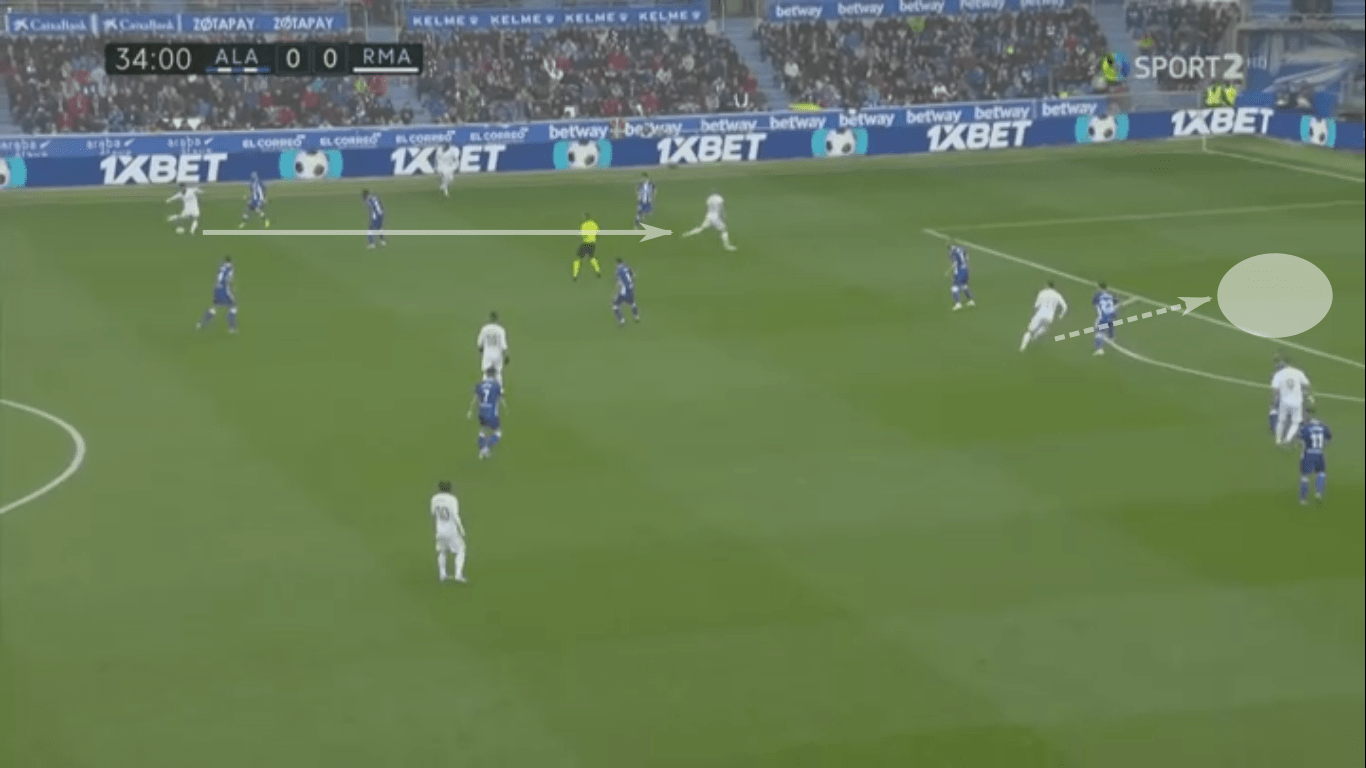
Kroos went anyway. As mentioned, the gap is huge, but the play developed a bit too slowly in this instance, ending in a turnover. Regardless of the way this particular play resulted, Real Madrid hoped to the half-spaces with runs from deep. This sequence highlighted the patience Real Madrid showed to allow for those high movements, the complexity of the runs and the willingness to keep moving the ball to move the defence until they created an opportunity that was worth the risk of the penetrating pass.
Conclusion
Weather conditions made this a very difficult, pragmatic game. Ramos got his goal on a set-piece, Pérez equaled with a penalty kick and Carvajal scored a 69th-minute winner. It’s a fair result as Real Madrid managed an xG of 2.03 to Alavés’ 1.33.
Real Madrid will turn their attention to Saturday’s game against Espanyol. The schedule ramps up after that with a Champions League fixture against Club Brugge followed by La Liga games at Valencia and Barcelona. The health of Eden Hazard will be a major talking point in the build-up to El Classico.
For Alavés, they’re catching Grenada at the right moment, the host cellar-dwellers Leganes. Picking up six points in the next couple of weeks could have them within a game of the top six. They’ll look to rebound with better performances in win-able games.

If you love tactical analysis, then you’ll love the digital magazines from totalfootballanalysis.com – a guaranteed 100+ pages of pure tactical analysis covering topics from the Premier League, Serie A, La Liga, Bundesliga and many, many more. Buy your copy of the November issue for just ₤4.99 here





Comments